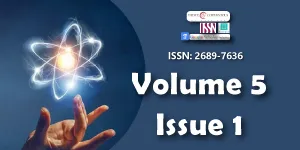On Algebra, Cosmic Triangles and the shape of our Universe
Main Article Content
Abstract
The curvature parameter k and the density parameter omega play the dominant phenomena determining the fate of our universe. According to these two scales, the geometry of the universe has three possibilities namely, flat, open, or closed. The flat and open universe will have continual expansion. But the closed universe will turn around and collapse. If k is zero, the universe is flat, if it is greater than zero, it is closed and if k is less than zero the universe will be open. And if the density parameter Omega is one (1), the universe is flat, if it is greater than one, the universe will be closed and if it is less than one, the universe is open. The main thing is that if the sum of the interior angles of the cosmic triangles is equal to 180 degrees, the geometry of our universe is flat /Euclidean If it is less than 180 degrees, the shape of our universe is open/ hyperbolic and if it is greater than 180 degrees it is closed/elliptic. In this short work, by applying the fundamental operations of classical algebra to the cosmic triangles, the author attempts to prove that the shape of our universe is flat.
Downloads
Article Details
Copyright (c) 2022 Kalimuthu S.

This work is licensed under a Creative Commons Attribution 4.0 International License.
Licensing and protecting the author rights is the central aim and core of the publishing business. Peertechz dedicates itself in making it easier for people to share and build upon the work of others while maintaining consistency with the rules of copyright. Peertechz licensing terms are formulated to facilitate reuse of the manuscripts published in journals to take maximum advantage of Open Access publication and for the purpose of disseminating knowledge.
We support 'libre' open access, which defines Open Access in true terms as free of charge online access along with usage rights. The usage rights are granted through the use of specific Creative Commons license.
Peertechz accomplice with- [CC BY 4.0]
Explanation
'CC' stands for Creative Commons license. 'BY' symbolizes that users have provided attribution to the creator that the published manuscripts can be used or shared. This license allows for redistribution, commercial and non-commercial, as long as it is passed along unchanged and in whole, with credit to the author.
Please take in notification that Creative Commons user licenses are non-revocable. We recommend authors to check if their funding body requires a specific license.
With this license, the authors are allowed that after publishing with Peertechz, they can share their research by posting a free draft copy of their article to any repository or website.
'CC BY' license observance:
|
License Name |
Permission to read and download |
Permission to display in a repository |
Permission to translate |
Commercial uses of manuscript |
|
CC BY 4.0 |
Yes |
Yes |
Yes |
Yes |
The authors please note that Creative Commons license is focused on making creative works available for discovery and reuse. Creative Commons licenses provide an alternative to standard copyrights, allowing authors to specify ways that their works can be used without having to grant permission for each individual request. Others who want to reserve all of their rights under copyright law should not use CC licenses.
Link: https://bit.ly/3D4hMuc
Link: https://bit.ly/3ix9dyz
Link: https://bit.ly/3un2zR0
Link: https://bit.ly/36mDg9H
Link: https://bit.ly/36hSsVK
(2021) Academia Arena. 13. Link: https://bit.ly/3Iugdqw
S Kalimuthu (2020) On freedman equation and the shape of our universe. Ann Math Phys 30-31. Link: https://bit.ly/36HIs7I
S Kalimuthu (2021) On Friedman equation, quadratic laws and the geometry of our universe. Int J Phys Res Appl 48-50. Link: https://bit.ly/3IAAjze

